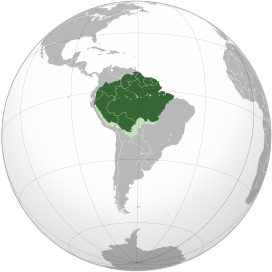
Back Amasonereënwoud Afrikaans غابة الأمازون Arabic ܥܒܐ ܕܐܡܙܘܢ ARC غابة د لأمازون ARY غابة الامازون ARZ Amazonia AST Amazon yağış meşələri Azerbaijani آمازون یاغیش مشهلری AZB Amazuonėjė BAT-SMG Дажджавыя лясы Амазоніі Byelorussian
| Amazon rainforest Portuguese: Floresta amazônica Spanish: Selva amazónica Dutch: Amazoneregenwoud | |
|---|---|
 Map of the Amazon rainforest ecoregions as delineated by the WWF in dark green[1] and the Amazon drainage basin in light green. | |
| Geography | |
| Location | Bolivia, Brazil, Colombia, Ecuador, French Guiana (France), Guyana, Peru, Suriname, and Venezuela |
| Coordinates | 3°S 60°W / 3°S 60°W |
| Area | 5,500,000 km2 (2,100,000 sq mi) |
The Amazon rainforest,[a] also called Amazon jungle or Amazonia, is a moist broadleaf tropical rainforest in the Amazon biome that covers most of the Amazon basin of South America. This basin encompasses 7,000,000 km2 (2,700,000 sq mi),[2] of which 6,000,000 km2 (2,300,000 sq mi) are covered by the rainforest.[3] This region includes territory belonging to nine nations and 3,344 formally acknowledged indigenous territories.
The majority of the forest, 60%, is in Brazil, followed by Peru with 13%, Colombia with 10%, and with minor amounts in Bolivia, Ecuador, French Guiana, Guyana, Suriname, and Venezuela. Four nations have "Amazonas" as the name of one of their first-level administrative regions, and France uses the name "Guiana Amazonian Park" for French Guiana's protected rainforest area. The Amazon represents over half of Earth's remaining rainforests,[4] and comprises the largest and most biodiverse tract of tropical rainforest in the world, with an estimated 390 billion individual trees in about 16,000 species.[5]
More than 30 million people of 350 different ethnic groups live in the Amazon, which are subdivided into 9 different national political systems and 3,344 formally acknowledged indigenous territories. Indigenous peoples make up 9% of the total population, and 60 of the groups remain largely isolated.[6]
Large scale deforestation is occurring in the forest, creating different harmful effects. Economic losses due to deforestation in Brazil could be approximately 7 times higher in comparison to the cost of all commodities produced through deforestation. In 2023, the World Bank published a report proposing a non-deforestation based economic program in the region.[7][8]
- ^ "WWF – About the Amazon". Archived from the original on October 7, 2019. Retrieved October 11, 2019.
- ^ "Amazon River". britannica.com. Encyclopaedia Britannica. January 11, 2024.
- ^ "Amazon Rainforest". britannica.com. Encyclopaedia Britannica. May 30, 2024.
- ^ "WNF: Places: Amazon". Archived from the original on April 13, 2020. Retrieved June 4, 2016.
- ^ "Field Museum scientists estimate 16,000 tree species in the Amazon". Field Museum. October 17, 2013. Archived from the original on December 7, 2019. Retrieved October 18, 2013.
- ^ "Inside the Amazon". Archived from the original on October 7, 2019. Retrieved November 5, 2020.
- ^ Cite error: The named reference
TheWorldBankwas invoked but never defined (see the help page). - ^ Cite error: The named reference
Balancingwas invoked but never defined (see the help page).
Cite error: There are <ref group=lower-alpha> tags or {{efn}} templates on this page, but the references will not show without a {{reflist|group=lower-alpha}} template or {{notelist}} template (see the help page).
© MMXXIII Rich X Search. We shall prevail. All rights reserved. Rich X Search